Standard [CURRENT]
ASTM D 8186:2025
Standard Test Method for Measurement of Impurities in Graphite by Electrothermal Vaporization Inductively Coupled Plasma Optical Emission Spectrometry (ETV-ICP-OES)
- Publication date
- 2025
- Original language
- English
- Pages
- 11
- Publication date
- 2025
- Original language
- English
- Pages
- 11
- DOI
- https://dx.doi.org/10.1520/D8186-25
Product information on this site:
Quick delivery via download or delivery service
Buy securely with a credit card or pay upon receipt of invoice
All transactions are encrypted
Short description
1.1 This test method covers the measurement of mass fractions of the elements silver (Ag), aluminum (Al), arsenic (As), boron (B), barium (Ba), berylium (Be), bismuth (Bi), calcium (Ca), cadmium (Cd), cobalt (Co), chromium (Cr), copper (Cu), iron (Fe), potassium (K), lithium (Li), magnesium (Mg), manganese (Mn), molybdenum (Mo), sodium (Na), nickel (Ni), phosphorus (P), lead (Pb), sulfur (S), antimony (Sb), silicon (Si), tin (Sn), strontium (Sr), titanium (Ti), vanadium (V), tungsten (W), yitrium (Y), zinc (Zn), and zirconium (Zr) in graphite. 1.2 The scope of this test method is limited to those elements that have measurable mass fractions in the graphite sample used in the interlaboratory study for determination of precision data. Provided that an appropriate validation procedure is carried out, this test method is also applicable to other elements. Note 1: For example, this test method was successfully applied to the measurement of the elements Dy, Eu, Gd, and Sm whose mass fractions in the sample are used to calculate the equivalent boron concentration of nuclear graphites. 1.3 Provided that an appropriate validation procedure is carried out, this test method is also applicable to other carbon materials such as coal, coke, carbon black, graphite-felt, graphite-foil, graphite-foam, and fiber reinforced carbon-carbon composites. Note 2: For example, this test method was successfully applied to the measurement of trace-impurities in high-purity graphite-felt which is used for the production of monocrystalline silicon. 1.4 This test method is applicable to element contents from approximately 0.0005 mg/kg to 50 mg/kg, depending on element, wavelength, measurement parameters, and sample mass. The working range can be extended to higher element contents by selecting less sensitive emission lines or adaption of sample mass, or both. 1.5 The values stated in SI units are to be regarded as standard. The values given in parentheses after SI units are provided for information only and are not considered standard. 1.6 This standard does not purport to address all of the safety concerns, if any, associated with its use. It is the responsibility of the user of this standard to establish appropriate safety, health, and environmental practices and determine the applicability of regulatory limitations prior to use. 1.7 This international standard was developed in accordance with internationally recognized principles on standardization established in the Decision on Principles for the Development of International Standards, Guides and Recommendations issued by the World Trade Organization Technical Barriers to Trade (TBT) Committee.
ICS
71.060.10
DOI
https://dx.doi.org/10.1520/D8186-25
Also available in
Loading recommended items...
Loading recommended items...
Loading recommended items...

